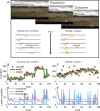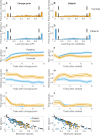All or nothing belief updating in patients with schizophrenia reduces precision and flexibility of beliefs
- PMID: 33434284
- PMCID: PMC8041039
- DOI: 10.1093/brain/awaa453
All or nothing belief updating in patients with schizophrenia reduces precision and flexibility of beliefs
Abstract
Schizophrenia is characterized by abnormal perceptions and beliefs, but the computational mechanisms through which these abnormalities emerge remain unclear. One prominent hypothesis asserts that such abnormalities result from overly precise representations of prior knowledge, which in turn lead beliefs to become insensitive to feedback. In contrast, another prominent hypothesis asserts that such abnormalities result from a tendency to interpret prediction errors as indicating meaningful change, leading to the assignment of aberrant salience to noisy or misleading information. Here we examine behaviour of patients and control subjects in a behavioural paradigm capable of adjudicating between these competing hypotheses and characterizing belief updates directly on individual trials. We show that patients are more prone to completely ignoring new information and perseverating on previous responses, but when they do update, tend to do so completely. This updating strategy limits the integration of information over time, reducing both the flexibility and precision of beliefs and provides a potential explanation for how patients could simultaneously show over-sensitivity and under-sensitivity to feedback in different paradigms.
Keywords: belief updating; computational psychiatry; learning; schizophrenia.
© The Author(s) (2021). Published by Oxford University Press on behalf of the Guarantors of Brain. All rights reserved. For permissions, please email: journals.permissions@oup.com.
Figures






References
-
- Adams RP, MacKay DJC. Bayesian online change point detection. eprint arXiv:0710.3742 2007. Available from https://arxiv.org/abs/0710.3742.
-
- Andreasen NC. Scale for the Assessment of Positive Symptons (SAPS). Iowa City, Iowa: The University of Iowa; 1984.
-
- Behrens TEJ, Woolrich MW, Walton ME, Rushworth MFS.. Learning the value of information in an uncertain world. Nat Neurosci 2007; 10: 1214–21. - PubMed
Publication types
MeSH terms
Grants and funding
LinkOut - more resources
Full Text Sources
Other Literature Sources
Medical

